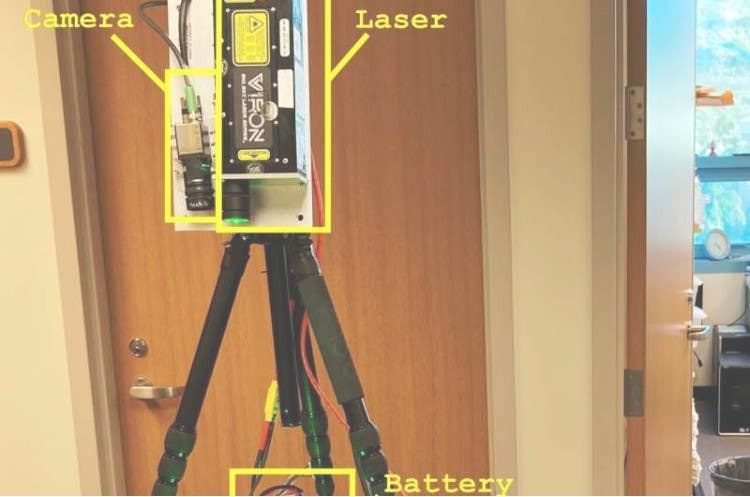Biofinder changes the game in searching for extraterrestrial life
At present, there is no other equipment that can detect minute amounts of bio-residue on a rock during the daytime. Biofinder can.

[June 26, 2022: Marcie Grabowski, University of Hawaii at Manoa]
Battery operated Biofinder looking at fossil sample from 50 cm distance. (CREDIT: Anupam Misra, UH SOEST)
An innovative scientific instrument, the Compact Color Biofinder, developed by a team of University of Hawai‘i at Mānoa researchers, may change the game in the search for signs of extraterrestrial life.
Most biological materials, for example, amino acids, fossils, sedimentary rocks, plants, microbes, proteins and lipids, have strong organic fluorescence signals that can be detected by specialized scanning cameras. In a study published in Nature Scientific Reports recently, the research team reported that the Biofinder is so sensitive that it can accurately detect the bio-residue in fish fossils from the 34-56 million year-old Green River formation.
“The Biofinder is the first system of its kind,” said Anupam Misra, lead instrument developer and researcher at the Hawai‘i Institute of Geophysics and Planetology at the UH Mānoa School of Ocean and Earth Science and Technology (SOEST). “At present, there is no other equipment that can detect minute amounts of bio-residue on a rock during the daytime. Additional strengths of the Biofinder are that it works from a distance of several meters, takes video and can quickly scan a large area.”
Biofinder detection of biological resides in fish fossil. (a) White light image of a Green River formation fish fossil (b) Fluorescence image of the fish fossil obtained by the Biofinder (c) Close-up white light image of the fish fossil cross-section (d) Fluorescence image showing strong bio-fluorescence from the fish remains. (CREDIT: Misra, et al., 2022)
Related Stories:
Though the Biofinder was first developed in 2012 by Misra, advances supported by the NASA PICASSO program culminated in the latest color version of the compact Biofinder.
Finding evidence of biological residue in a vast planetary landscape is an enormous challenge. So, the team tested the Biofinder’s detection abilities on the ancient Green River fish fossils and corroborated the results through laboratory spectroscopy analysis, scanning electron microscopy and fluorescence lifetime imaging microscopy.
“There are some unknowns regarding how quickly bio-residues are replaced by minerals in the fossilization process,” said Misra. “However, our findings confirm once more that biological residues can survive millions of years, and that using biofluorescence imaging effectively detects these trace residues in real time.”
The search for life—which may be existing or extinct—on planetary bodies is one of the major goals of planetary exploration missions conducted by NASA and other international space agencies.
“If the Biofinder were mounted on a rover on Mars or another planet, we would be able to rapidly scan large areas quickly to detect evidence of past life, even if the organism was small, not easy to see with our eyes, and dead for many millions of years,” said Misra. “We anticipate that fluorescence imaging will be critical in future NASA missions to detect organics and the existence of life on other planetary bodies.”
“The Biofinder’s capabilities would be critical for NASA’s Planetary Protection program, for the accurate and no-invasive detection of contaminants such as microbes or extraterrestrial biohazards to or from planet Earth,” said Sonia J. Rowley, the team biologist and co-author on the study.
Misra and colleagues are applying to have the opportunity to send the Biofinder on a future NASA mission.
“The detection of such biomarkers would constitute groundbreaking evidence for life outside of planet Earth,” said Misra.
For more science and technology stories check out our New Discoveries section at The Brighter Side of News.
Note: Materials provided above by University of Hawaii at Manoa. Content may be edited for style and length.
Like these kind of feel good stories? Get the Brighter Side of News' newsletter.
Joseph Shavit
Head Science News Writer | Communicating Innovation & Discovery
Based in Los Angeles, Joseph Shavit is an accomplished science journalist, head science news writer and co-founder at The Brighter Side of News, where he translates cutting-edge discoveries into compelling stories for a broad audience. With a strong background spanning science, business, product management, media leadership, and entrepreneurship, Joseph brings a unique perspective to science communication. His expertise allows him to uncover the intersection of technological advancements and market potential, shedding light on how groundbreaking research evolves into transformative products and industries.



